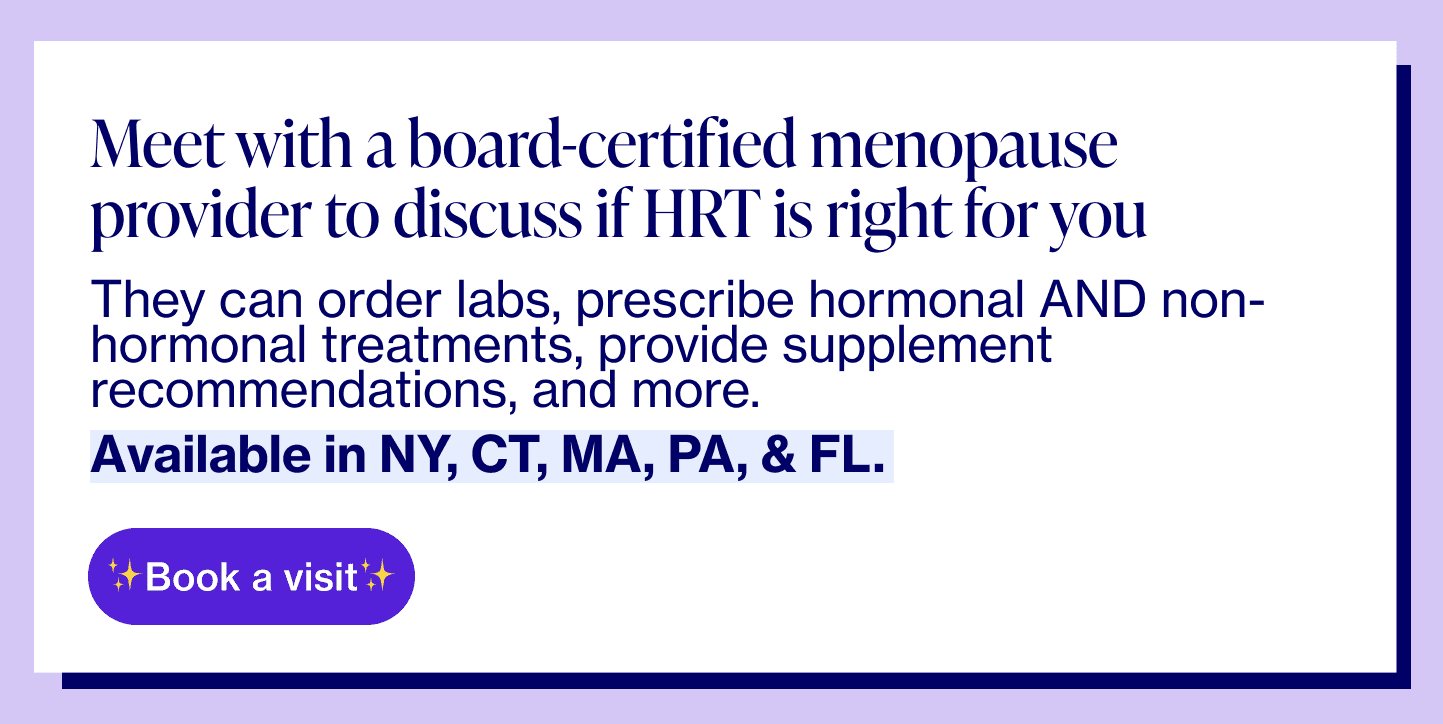
Published on Jun 25, 2024
Last modified on Sep 24, 2024
What To Know About Birth Control In Perimenopause
6 min read

When we think about who “needs” birth control, midlife and perimenopausal women aren’t always the first age group that comes to mind. But while fertility does begin to decline in our mid-30s, that certainly does not rule out the possibility of pregnancy. So, you may be smack in the middle of perimenopause — with the hot flashes to show for it no less — but until that one-year mark following the last menstrual period (aka menopause), pregnancy isn’t out of the question. We broke down everything to know about birth control during perimenopause, including options that can help with menopausal symptoms.
Birth control options
Oral contraceptives (AKA birth control pill)
- Combination pill – Contains both an estrogen and progestin and works by suppressing endogenous ovarian function, thereby preventing ovulation
- Mini pill – Contains only a progestin and works by thickening cervical mucus and thinning the uterine lining. This prevents the sperm from reaching the egg and prevents a fertilized egg from attaching to the uterine wall. Progestin-only pills often do stop ovulation, but do not do so consistently. About 4 in 10 women who use progestin-only pills will continue to ovulate.
When used correctly, the birth control pill is 99% effective, but due to people forgetting to take or missing pills, it ends up being about 93% effective.
RELATED: Progesterone vs Progestin: What’s The Difference?
Intrauterine devices (IUDs)
IUDs are T-shaped devices that are inserted through the cervix and into the uterus. They work by preventing the movement of sperm to the egg, thus preventing pregnancy. There are two types of IUD:
- Hormonal – The progestin in hormonal IUDs thickens cervical mucus, which blocks and traps sperm. This option may also prevent ovulation, meaning no egg is released = no chance of fertilization.
- Non-hormonal – Non-hormonal IUDs are made with copper, which harms sperm motility and prevents sperm from reaching the egg.
IUDs are used locally, meaning they work directly in the uterus and are not intended to have systemic effects to help with symptoms like hot flashes, for example (whereas a systemic option like oral contraceptive pills could). They are typically 99% effective, can last 3-10 years depending on the type, and can be a great option for people who want long-term birth control with the ability to get pregnant after.
Are there any other non-hormonal contraceptive options?
You bet. Evofem launched Phexxi, a novel, FDA-approved non-hormonal method in 2020. This contraceptive gel is inserted into the vagina (the applicator looks like a skinny tampon) 0-60 minutes before intercourse. When used correctly, Phexxi is typically 93% effective at preventing pregnancy. This is a great option for those who don’t want to take a pill everyday or cannot take hormonal medication due to medical conditions including certain types of cancer, history of blood clots, and heart disease.
This is by no means an exhaustive list of all forms of birth control — there are several alternative hormonal birth control options like the Depo Provera shot, the patch, and vaginal ring. Barrier methods like diaphragms and condoms are also effective ways of preventing pregnancy. It’s important to note that only condoms prevent both pregnancy and STIs.
What about natural family planning?
AKA the “rhythm method,” natural family planning involves tracking periods to assess when you are most fertile and should avoid unprotected sex. Due to irregular menstrual cycles, this method is not recommended for women in perimenopause.
What else is birth control used for besides pregnancy prevention?
Managing symptoms
Outside of pregnancy prevention, birth control is a good option for women with symptoms of perimenopause who also require or desire contraception. As we know, hormone levels shift dramatically during perimenopause (we’re looking at you estrogen, progesterone, and follicle-stimulating hormone). But here’s where birth control can come in handy — both progestin-only contraception (aka the mini pill) and combined oral contraceptives can help with irregular periods, but the latter can also mitigate vasomotor symptoms (hot flashes & night sweats). For those who aren’t good candidates for combined pills due to high blood pressure, a history of blood clots or cigarette use over the age of 25, progestin-only pills are recommended.
Reducing the risk of certain cancers
Additionally, the use of combined oral contraceptives (combination pill) may significantly reduce risk of ovarian and endometrial cancer. Estrogen-containing birth control started in adulthood may also help improve bone health and strength, which is particularly important during menopause when we are at increased risk for osteoporosis.
Don’t want to take a pill everyday? In addition to preventing pregnancy, progestin-containing IUDs keep the uterine lining super thin, making it a great choice for those with heavy or irregular bleeding in perimenopause and for preventing uterine cancer.
Are there any risks associated with combined oral contraceptive use during perimenopause?
While combined oral contraceptives are safe for most women in perimenopause, it is recommended that women with a history of the following conditions avoid estrogen-containing birth control:
- Breast cancer
- Endometrial cancer
- Ovarian cancer
- Risk of blood clots
- Cardiovascular disease
- High blood pressure
- Diabetes
READ MORE: Metabolic Health & Menopause: What’s The Connection?
When should I stop taking birth control?
This is where things can get a little tricky. For women who have been on birth control throughout their 30s or 40s, that contraceptive use can mask some of the trademark symptoms that usually tip us off to perimenopause. Plus, we know that the official marker of menopause is no menstrual bleeding for 12+ months, but since some birth control methods stop our period or cause irregular bleeding, the 12 month marker isn’t always foolproof.
Many providers recommend women stop hormonal birth control around the age of 51, since this is the average age of menopause and conception after 50 is unlikely, but it varies person-to-person. We recommend speaking to your healthcare provider, or an Elektra clinician, to understand what makes most sense for you individually.
READ MORE: How To Know When Menopause Is Over
What’s the difference between hormonal birth control & menopause hormone therapy (MHT)?
If the potential benefits of combined oral contraceptives are sounding very similar to MHT (previously referred to as hormone replacement therapy/HRT), you’ve been doing your reading. And while there is some overlap between the two, they’re not actually the same thing. Unlike typical birth control pills, which contain 10-50 micrograms of estrogen, estrogen prescribed for menopause specifically at the lowest dose contains only 10-20 micrograms. In other words, estrogen prescribed for menopause can be a smaller fraction (⅓ to ½ ) of the estrogen in a birth control pill.
Additionally, oral contraceptives contain synthetic versions of the hormones (such as ethinyl estradiol and norethindrone) whereas MHT is often (but not always) prescribed as the bioidentical hormones estradiol and progesterone — meaning they have the same molecular and chemical structure as those produced in our body. Many women tend to respond better to the latter in perimenopause, however this varies person to person.
The key difference between low-dose birth control and MHT is that, unlike birth control, MHT doesn’t suppress the production of your own hormones. Instead, it adds hormones to your body to balance out what your ovaries are producing less of. That’s why MHT is most often prescribed just as you reach the postmenopause threshold.
READ MORE:




